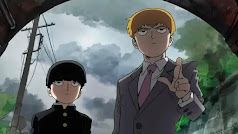Kate: Gyousou’s storyline in Hills of Silver Ruins has an Obi Wan Kenobi in Star Wars IV aura about it, the shadowy master Jedi who is still alive and eventually reveals himself to others.
Star Wars has many of the elements of manga, including the ongoing networks of various characters. Comments on Literature Devil indicate that people who know their Star Wars universe really know their Star Wars universe. Japanese manga/anime fans can definitely relate!
How do the Japanese feel about Star Wars?
Eugene: I don't think that Star Wars ever embedded itself in the popular zeitgeist. Rather it was the Japanese interpretations that subsequently took hold. Though to give home-grown originality credit where it's due, the enormously influential Space Battleship Yamato premiered in 1974. So while not conflating correlation with causation, 1977 does seem to have been an important science fiction pop-culture turning point in Japan too.
Leiji Matsumoto followed up Space Battleship Yamato (whose latest installment came in 2021) with Galaxy Express 999 and Space Pirate Captain Harlock in 1977. The Gundam franchise launched in 1979 and is still a going concern, with The Witch from Mercury debuting last year. Much like Star Trek, Gundam was supported during its original run by a devoted fan base and later skyrocketed in popularity.
Gundam wasn't the first, but it pretty much defined the mecha giant robot genre (and all the merchandizing that goes with it). It also showcased one of the most enduring and ubiquitous tropes in the contemporary fantasy and science fiction genres, namely the ordinary kid who discovers he has great nascent powers. With grueling effort and sacrifice (and a mentor), he masters those powers in time to save the day.
 Luke Skywalker, again. Except that archetype is sure looking
like a rare species in Hollywood these days. Demon Slayer was followed
by the enormous success of Jujutsu Kaisen in 2022, which took the same
basic story and moved it from the early 20th century to the early 21st century.
Okay, Peter Parker has a growth arc, but he powers up pretty fast and he got
his superpowers from an external source.
Luke Skywalker, again. Except that archetype is sure looking
like a rare species in Hollywood these days. Demon Slayer was followed
by the enormous success of Jujutsu Kaisen in 2022, which took the same
basic story and moved it from the early 20th century to the early 21st century.
Okay, Peter Parker has a growth arc, but he powers up pretty fast and he got
his superpowers from an external source.
Another commonality with Luke, Buffy, and Harry Potter is that many Japanese superheroes inherited their powers. Natsume in Natsume's Book of Friends traces his gifts to his grandmother. In Mob Psycho100, Mob's brother also has psychic powers. Shinjiro becomes the next Ultraman after his father. For key members of the Demon Slayer Corps, it is the "family business."
Family businesses in Japan (especially in the crafts) proudly announce how many generations they have been in business. (This is where adult adoption comes in handy.) The administration of Buddhist and Shinto temples has long been passed down along family lines. As in My Master Has No Tail, the master of a traditional Japanese art (rakugo, in this case) passes his stage name down to his senior apprentice.
Kabuki actor Hiroyuki Yamamoto performs as Kataoka Ainosuke VI, meaning that stage name has been passed down for six generations.
Kate: Star Wars indirectly furthered classic archetypes in the science-fiction community. Did 1977 Star Wars accomplish anything else behind the scenes?
Eugene: Star Wars also helped to win mainstream acceptance for science fiction in general.
Hayao Miyazaki's first feature film was The Castle of Cagliostro in 1979. Now considered a minor classic, it barely broke even at the box office. Observing that science fiction was all the rage, his producer, Toshio Suzuki, suggested that he try his hand at the genre. Miyazaki's next film was the post-apocalyptic Nausicaä of the Valley of the Wind in 1984. Its success financed the founding of Studio Ghibli a year later.
Miyazaki would later turn to science fiction and fantasy tropes more specific to Japan in films such as Spirited Away and Princess Monoke. While Hollywood has its own versions of what I call "spirit world warriors," starting with Van Helsing and epitomized by Buffy the Vampire Slayer and Constantine, Shinto (along with the Chinese wuxia genre), provides a rich menagerie of monsters and otherworldly beings.Demon Slayer and Jujutsu Kaisen demonstrate that a mix of Shinto and Buddhist pop theology has no problem finding an international audience. And this leads to my theory about why Japanese science fiction does cyberpunk so much better than Hollywood, despite the US actually being more "wired" than Japan.
In Shinto, the "ghost in the machine" is a "real" ghost. Just as tsukumogami are not inherently good or bad, the same holds for technology and AI in all its forms. That's why Purin in Ghost in the Shell: SAC_2045 getting resurrected as a sentient android is not an "Oh, no!" moment. It's just the same old Purin in a different container.






